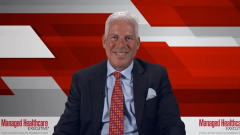Treatment Approaches in Wet AMD
Steven Peskin, MD, MBA, FACP, discusses drivers of cost and goals of therapy in wet AMD, and Diana Do, MD, discusses the different treatment approaches to the disease.
Episodes in this series
Steven Peskin, MD, MBA, FACP: Thinking about the key drivers of costs for wet AMD [age-related macular degeneration], in addition to the cost themselves, the cost of the therapy would be the key driver. There are several available therapies to treat wet age-related macular degeneration. There are other individuals who will often have certain comorbidities, which can be other drivers of cost of care, which may or may not be directly related to the AMD and a loss of visual acuity.
Thinking about the goals of therapy for patients with wet AMD, certainly it’s the attenuation of the problem. How is the wet AMD arrested or stopped, which will allow the patient to preserve a certain level of vision? There are clearly tests that are done by the retina ophthalmologist to look at that preservation or the reduction in the degradation of visual acuity, sight being arguably 1 of our most important senses that we have. Thus, being able to stop or arrest or reduce the rate of decline of loss of vision is paramount.
Diana Do, MD: In wet age-related macular degeneration, the gold standard treatment is intravitreal VEGF inhibitors. Many of these medicines were FDA approved based on positive data from phase 3 clinical trials. In these pivotal clinical trials, many of these medicines were given at fixed dosing regimens, and that provides us with level 1 evidence for the treatment of these diseases. In clinical practice, retina specialists often individualize the therapy for each patient. Because of this individualized and personalized therapy, sometimes patients are on different dosing regimens. The most popular dosing regimen in the United States for the treatment of wet age-related macular degeneration is a treat-and-extend regimen, which allows patients to potentially have fewer injections but with still the same efficacious results.
Many retina specialists prefer to treat their patients with wet age-related macular degeneration on a treat-and-extend dosing regimen. Treat and extend refers to properly treating an eye with age-related macular degeneration, that has active choroidal neovascularization, usually with a series of 3 injections at the initiation. Then, carefully monitoring the patient and extending the treatment interval if the disease is stable. This contrasts with the pivotal clinical trials of ranibizumab or aflibercept, where these medicines were given either every month or every 2 months on a fixed regimen. Retina specialists prefer the treat-and-extend regimen because it allows us to personalize the treatment to each individual patient. Not every patient needs frequent, high-frequency dosing over the course of their disease treatment. Therefore, the treat-and-extend regimen allows us to monitor the patient and treat them appropriately according to their disease activity.
Transcript edited for clarity.
Newsletter
Get the latest industry news, event updates, and more from Managed healthcare Executive.

























































